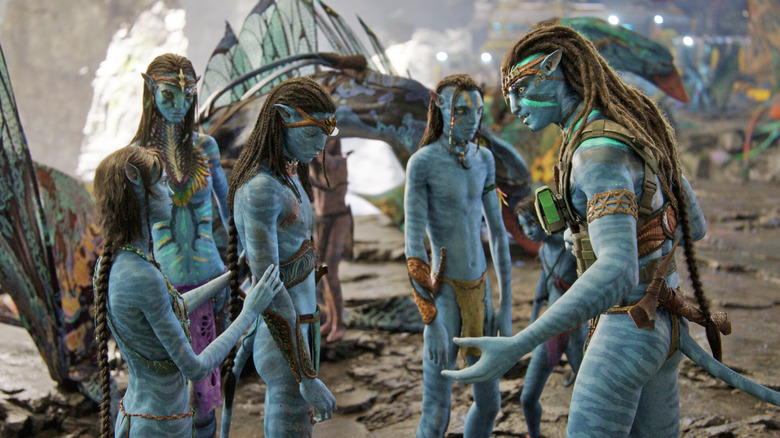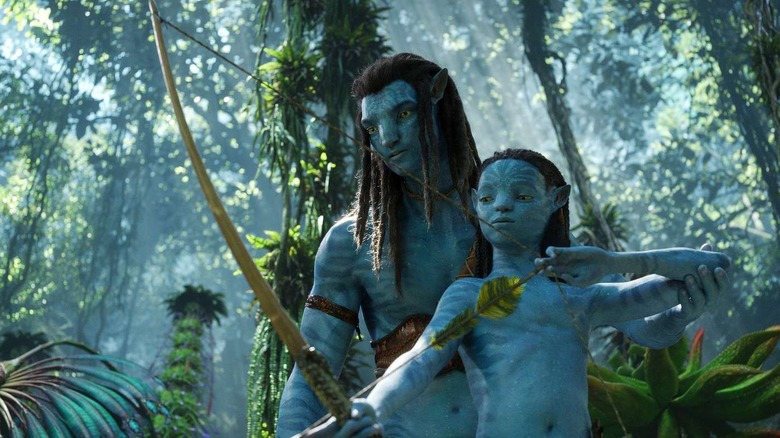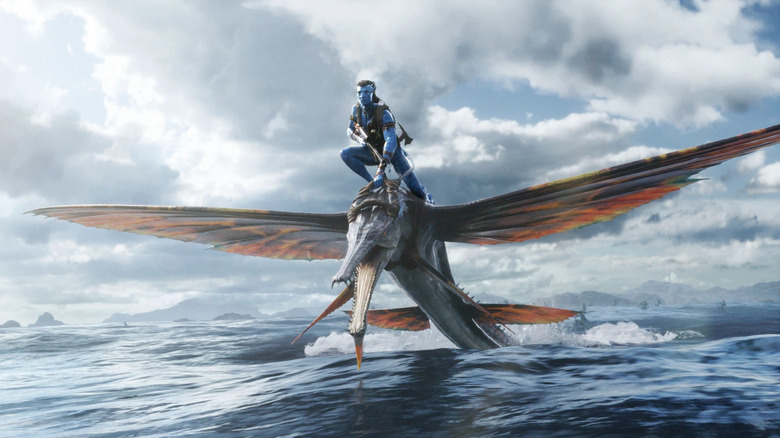Avatar: The Way Of Water Spoiler Review: A Gorgeous Cinematic Experience That Tries To Transcend Storytelling
If any of us had a dime for every time someone in the last 13 years has said, "Yeah, but who remembers 'Avatar'?", we'd be rich enough to buy Twitter. For all the times someone has doubted the staying power of the 2009 James Cameron film about a human who learns the ways of an alien culture and eventually becomes that culture's new leader, "Avatar" has stuck around in some form in the cultural consciousness, whether by manifesting doubt that a sequel could ever work especially more than a decade later or through the largely very popular theme-park land in Walt Disney World. But now, after what does feel like a countless number of delays and expansions, Cameron has returned to theaters with the second of his stories of Pandora, "Avatar: The Way of Water." Aside from being somewhat amazing that this sequel really does finally, tangibly exist, what occurs within the sequel is equally amazing at least from a visual point of view.
There's admittedly something funny about this being a spoiler review, because once you watch "Avatar: The Way of Water," it becomes evident that much of this film is spoiler-proof in a certain way. There are no truly jaw-dropping twists in "The Way of Water," and that is largely by design. Arguably one of the biggest surprises comes early, as it becomes clear that Cameron and his co-writers, Rick Jaffa and Amanda Silver, are going to echo the broad good vs. evil struggle of the 2009 original, down to who the Na'Vi must fend off. Just as Jake Sully (Sam Worthington) and Neytiri (Zoe Saldana) are back in this story set more than a decade after the first one's events, so too is the nefarious Colonel Miles Quaritch (Stephen Lang).
Though we all thought Quaritch was dead at the end of the first "Avatar" — because ... well, y'know, Jake killed him — he has returned ... and this time in Na'Vi form! Yes, through some scientific mumbo-jumbo, enough of Quaritch's DNA has survived to be placed into a Na'Vi avatar and installed with just about all of Quaritch's memories. So naturally, when he (as well as a few of his fellow Marines, also turned into avatars) wakes up, he wants to take down Jake and Neytiri ... again. The scene in which nu-Quaritch learns what's up is through a recording, in which we see (for the only time in the film) the human Quaritch and the weaselly Parker Selfridge (Giovanni Ribisi, who should give his agent a raise for his impressively high billing in the end credits for an appearance that lasts less time than it takes for you to read this parenthetical).
But once the revived struggle becomes clear — Jake, Neytiri, and their now-grown quartet of children flee their home to create distance between themselves and Quaritch's band of meanies — the story becomes less about plot and more about experience. And it is here that I will say what is already obvious to you: if you are going to see "Avatar: The Way of Water," you should see it on the biggest, loudest screen possible. While "The Way of Water" is only so-so in terms of crafting memorable dialogue or storytelling nuances (the names of characters from the first film are easy enough to recall, yet very few of the new characters truly stand out except one human addition, about whom more later), its visuals are genuinely superlative. No review can possibly spoil the experience of putting on a pair of 3D glasses (because yes, once again, James Cameron is just about the only filmmaker you should trust with a 3D film) and seeing for yourself what actual movie magic can look like.
Defying all logic
Though the final hour of "Avatar: The Way of Water" is where the true action kicks in — at 190 minutes, this movie would seem like it's overly lengthy, but it is surprisingly speedy in spite of not being action-heavy for a while — the middle section is where the film shines. Jake and his family head away from their Omaticaya clan of the forest and land on the reefs of Pandora to join the Metkayina people of the sea, which means it's not just Jake who has to learn a new way of life, but his whole family. Initially, they're greeted warily by the leaders of the Metkayina, portrayed here by Cliff Curtis and Kate Winslet (the latter of whom sadly doesn't have that much to do in the whole affair, even considering the weird echoes of "Titanic" in the third act). But over time, Jake and his family, especially his middle son Lo'ak (Britain Dalton), become fully ensconced in ... well, in the way of water.
If there is a lesson to be learned for viewers of "The Way of Water," it's that special effects really can look this amazing in movies, and far too few movies do have truly special effects. In the marketing campaign for this film, James Cameron has spoken candidly about his opinion of the onslaught of comic-book movies that have become the dominant form of cinematic entertainment in the last decade-plus, and at the very least, when you watch "The Way of Water," you can see why the visuals in those films simply do not measure up. We're just over a month removed from "Black Panther: Wakanda Forever," in which a hero becomes similarly involved with a strange group of people who live in the water, climaxing in a big battle on a massive ship. The parallels may not seem entirely solid, but the problem is less that the comparisons aren't perfect as much as they are unfair. The special effects in "Wakanda Forever" are often full of seams, as you can almost envision where the blue-screen backgrounds exist in shot after shot.
The special effects in "The Way of Water" – especially in the sequences on the sea in the middle hour — are breathtaking to behold. Anyone with passing knowledge of how films work will know inherently that much of what's on screen has to be fake. Even if the actors filmed in a water tank, or some kind of a film set with an extensive amount of water, the characters themselves are as much a product of motion-capture technology as they are of computer effects and animation. (That doesn't even take into consideration the many sea creatures that Jake and his family encounter.) Any given shot in this film seems to be partially, if not fully, crafted via digital effects, and yet the seams are almost always invisible. (The words "Almost always" must be utilized here because while Cameron's preferred viewing method is via 3D and 48-frames-per-second, whenever rapid movement is visible on screen during those high-frame-rate shots, the viewing experience becomes briefly awkward. High frame rate may be the future, but the future is not yet here.) It is to this film's credit that if Cameron had wanted to just spend the entire time in the hangout vibes of the second hour, it would still be one of the most triumphant special-effects experiences in cinema history.
A waterlogged finale
But of course, while the story of "Avatar: The Way of Water" is not its strong suit, that story does have to come back to the forefront by the end. Just as Lo'ak has made his first real connection in the reef — in the form of an alien whale called a tulkun, named Payakan — after having felt like an awkward outcast for so long, Quaritch and his men return, with Quaritch's human son, Spider. It's still too early to know, at least as these words are typed, but Spider (Jack Champion) feels very much like a love-him-or-hate-him character. We first meet Spider, compared to a stray cat — though Spider's dad is the late Quaritch, he has been raised among the Na'Vi despite not looking like any of them. Spider has taken to the forests of Pandora quite well, speaking the language and sporting an unfortunate dreadlock-laden mane of hair. Though he's friends with Lo'ak, his older brother Neteyam, and their adopted sister Kiri (Sigourney Weaver, who is surprisingly convincing as both her human self and a sullen teenage Na'Vi born of that human's DNA), Spider is taken by the Quaritch avatar and used as a translator as the Marines lay waste to various reef tribes so they can find and kill Jake and Neytiri. Though Spider gets a first-row glimpse at how terrible Quaritch is — and the avatar version of his dad keeps reminding him that his real dad died a while ago, so there's no lingering emotion or paternal connection to be had — he continually aids his avatar dad unless he's vaguely shouting about how bad Quaritch is, both before and after the climactic battle.
The eventual battle between the Metkayina and Quaritch's group (the latter also including a group of humans who hunt tulkun for profit) comprises the third act of the film. The good and unsurprising news? Well, big shock, but James Cameron still knows how to effectively stage, choreograph, and mount big action setpieces. It speaks as much to his skills as an action filmmaker as to the skills of the countless men and women making the special effects a reality that much of the action-heavy final hour works as well as it does, because the action continues to feel real even though much of what's on screen can't possibly be real. Of course, if there is a demerit to the finale, it's that the stakes wind up seeming somewhat low. You may temporarily forget that Cameron has promised us all at least one more "Avatar" film (set to be released in 2024), but if this one makes enough money, Cameron also wants to make a fourth and fifth entry. So it should come as no surprise that the body count among characters who presumably matter in this greater franchise is very slim. Spider? Alive at the end, after having revived Quaritch's avatar for...reasons? Jake and Neytiri also both survive, along with three of their children. (The oldest son, Neteyam, dies midway through the extended climax.)
But the thing about "Avatar: The Way of Water" is that, beyond all skepticism, it's a movie that cannot truly be spoiled. If you are reading these words before seeing the film, you're not going to find that it ruins the experience for you. All the words in the language can't prepare you for the distinct pleasure of being enveloped in the world of Pandora for three hours, even if the character development, the dialogue (it is possible the word "Bro" is shouted eight million times in this movie), and the story aren't as memorable as the sight of space whales who can converse with the Na'Vi, or glowing objects floating underwater, or the ripples of the waves on non-human hands. It's a hell of a thing, this movie. It defies all logic.


